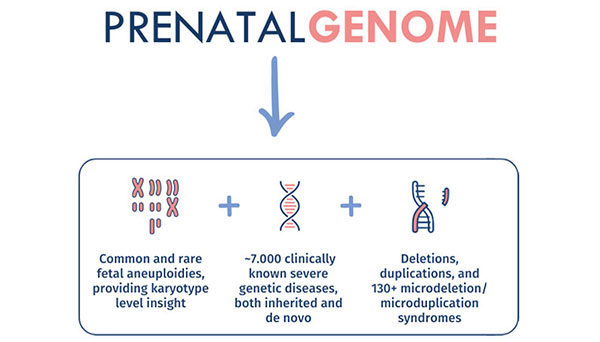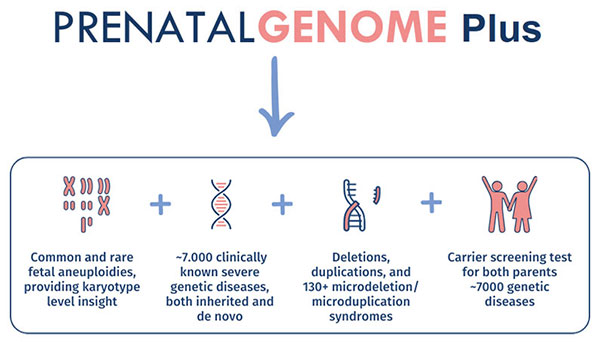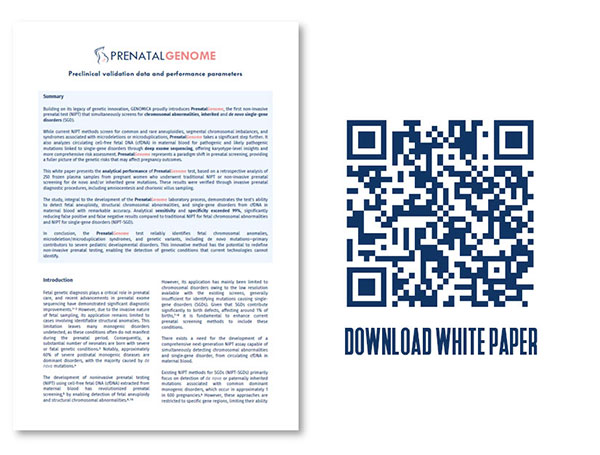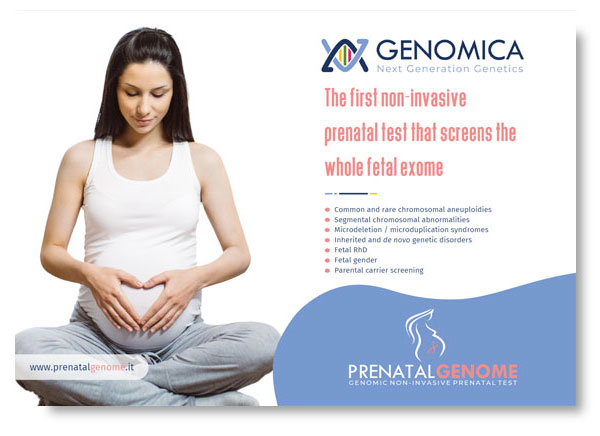PRENATALGENOME: the first non-invasive prenatal test that analyzes the entire fetal genome
Dear Customer,
we are excited to introduce PrenatalGenome, a cutting-edge non-invasive prenatal screening test (NIPT) that analyzes the entire coding fetal genome (exome). By examining circulating cell-free fetal DNA (cfDNA) from a maternal blood sample, it offers comprehensive screening for genome-wide chromosomal abnormalities and severe genetic disorders in the fetus. This approach provides unmatched accuracy and detection capabilities compared to other NIPT.
PrenatalGenome represents a significant technological advancement compared to conventional NIPTs, which, due to their low resolution, are limited to identifying fetal chromosomal aneuploidies and structural chromosomal abnormalities.
Thanks to its advanced technology, PrenatalGenome can detect:
✔️Common fetal aneuploidies (e.g., Trisomy 21, Trisomy 18, Trisomy 13, Monosomy X, Trisomy X, XXY, XYY).
✔️Rare fetal aneuploidies (e.g., Trisomy 9, Trisomy 16, Trisomy 22, with a higher incidence among rare aneuploidies).
✔️Structural chromosomal alterations (segmental deletions and duplications >7 Mb) across all chromosomes in the fetal karyotype.
✔️130+ Microdeletion / Microduplication Syndromes (down to 1 Mb in size)
✔️~7,000 Severe, clinically known genetic diseases with hereditary or de novo onset.
✔️The PrenatalGenome Plus level of screening also includes a carrier screening test for both parents to evaluate carrier status for gene mutations associated with ~7,000 genetic diseases.
All this is provided in a single test.
PrenatalGenome provides unparalleled insight into fetal genetic health through non-invasive prenatal testing. No other NIPT can deliver such a comprehensive level of pregnancy-related information.

PrenatalGenome uses the advanced ultra-deep Whole Exome Sequencing (WES) technology, covering over 20,000 genes, combined with sophisticated bioinformatic analysis and a proprietary algorithm.

Resolution refers to the sequencing depth (or coverage) of the test. This is a crucial feature since higher coverage ensures greater reliability of results and improved test performance.
Traditional NIPTs use very low sequencing depth (coverage 0.1X). This results in minimal coverage of genetic regions and restricts the test's focus to identifying only chromosomal abnormalities.
In contrast, PrenatalGenome employs ultra-deep sequencing technology (coverage >500X) to ensure complete coverage of coding regions in the fetal genome. This resolution, thousands of times higher than that of conventional NIPTs, enables the detection of a broad spectrum of genetic and chromosomal abnormalities with unprecedented reliability and much improved performance.


1️⃣ RETROSPECTIVE ANALYSIS OF 250 PLASMA SAMPLES
collected from pregnant women who underwent traditional NIPT (low resolution) and targeted non-invasive prenatal screening for a group of 79 genetic diseases (targeted SGD NIPT).
2️⃣ TEST RESULTS CONFIRMED USING INVASIVE PRENATAL DIAGNOSTIC TECHNIQUES (amniocentesis and chorionic villus sampling).
3️⃣ PRENATALGENOME DEMONSTRATED HIGHER SENSITIVITY AND SPECIFICITY COMPARED TO TRADITIONAL NIPTs.


More information about PRENATALGENOME can be found on the dedicated website www.prenatalgenome.it or by contacting our team of geneticists.
Our scientific-commercial representative in your area is available to provide further details on how to use the test and to explore the best collaboration opportunities with Genomica to introduce this examination into clinical practice.
If you are interested in receiving more information on PRENATALGENOME, we invite you to write to us:
Contact Genomica
We look forward to sharing the most advanced and innovative diagnostic solutions in the field of genetics.
GENOMICA srl
Marketing and Communication Department

